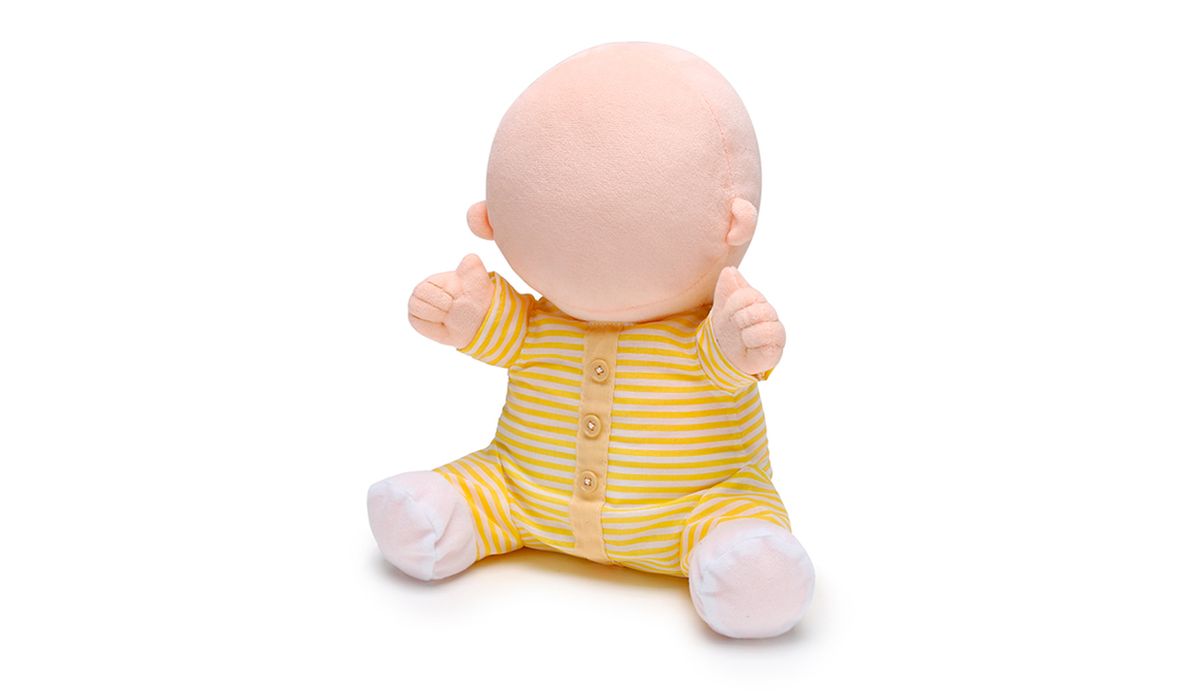This robot is Hiro-chan. It’s made by Vstone, a Japanese robotics company known for producing a variety of totally normal educational and hobby robotics kits and parts. Hiro-chan is not what we would call totally normal, since it very obviously does not have a face. Vstone calls Hiro-chan a “healing communication device,” and while the whole faceless aspect is definitely weird, there is a reason for it, which unsurprisingly involves Hiroshi Ishiguro and his ATR Lab.
Hiro-chan’s entire existence seems to be based around transitioning from sad to happy in response to hugs. If left alone, Hiro-chan’s mood will gradually worsen and it’ll start crying. If you pick it up and hug it, an accelerometer will sense the motion, and Hiro-chan’s mood will improve until it starts to laugh. This is the extent of the interaction, but you’ll be glad to know that the robot has access to over 100 utterance variations collected from an actual baby (or babies) to make sure that mood changes are fluid and seamless.
According to Japanese blog RobotStart, the target demographic for Hiro-chan is seniors, although it’s simple enough in operation that pretty much anyone could likely pick one up and figure out what they’re supposed to do with it. The end goal is the “healing effect” (a sense of accomplishment, I guess?) that you’d get from making the robot feel better.

So why doesn’t the robot have a face? Since the functionality of the robot depends on you getting it go from sad to happy, Vstone says that giving the robot a face (and a fixed expression) would make that much less convincing and emotionally fulfilling—the robot would have the “wrong” expression half the time. Instead, the user can listen to Hiro-chan’s audio cues and imagine a face. Or not. Either way, the Uncanny Valley effect is avoided (as long as you can get over the complete lack of face, which I personally couldn’t), and the cost of the robot is kept low since there’s no need for actuators or a display.

This concept that a user could imagine or project features and emotions onto a robot as long as it provides a blank enough slate came from Hiroshi Ishiguro with Telenoid, followed by Elfoid and Hugvie. While Telenoid and Elfoid did have faces, those faces were designed to look neither young nor old, and neither male nor female. When you communicate with another human through Telenoid or Elfoid, the neutral look of the robot makes it easier for you to imagine that it looks something like whoever’s on the other end. Or that’s the idea, anyway. Hiro-chan itself was developed in cooperation with Hidenobu Sumioka, who leads the Presence Media Research Group at Hiroshi Ishiguro Laboratory at ATR.
Vstone says the lack of a face is expected to enhance user attachment to the robot, and that testing during product development “showed that designs without faces were as popular as designs with faces.” Users can also enhance attachment by making clothing for the robot, Vstone suggests, and will provide patterns on its website when Hiro-chan is released. Otherwise, there’s really not much to the robot: It runs on AA batteries, has an on-off switch, and mercifully, a volume control, although the FAQ on the robot suggests that it may sometimes laugh even if it’s all by itself in a different room, which is not creepy at all.

At 5,500 JPY (about US $50), Vstone expects that Hiro-chan could be helpful with seniors in nursing homes, relating this anecdote:
In tests at nursing homes that cooperated with the development of Hiro-chan, even those who did not respond to facility staff etc., spontaneously started crying when Hiro-chan started crying, When "Hiro-chan" started laughing, she was seen smiling. By introducing "Hiro-chan", you can expect not only the healing of the user himself, but also the effect of reducing the labor of the facility staff.
Sounds like a great idea, but I still don’t want one.
[ Vstone ]
Evan Ackerman is a senior editor at IEEE Spectrum. Since 2007, he has written over 6,000 articles on robotics and technology. He has a degree in Martian geology and is excellent at playing bagpipes.



